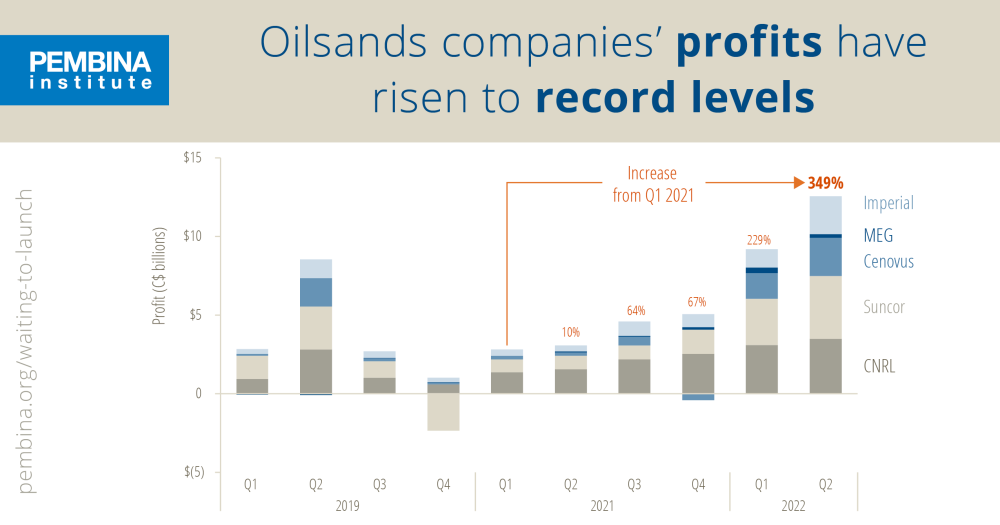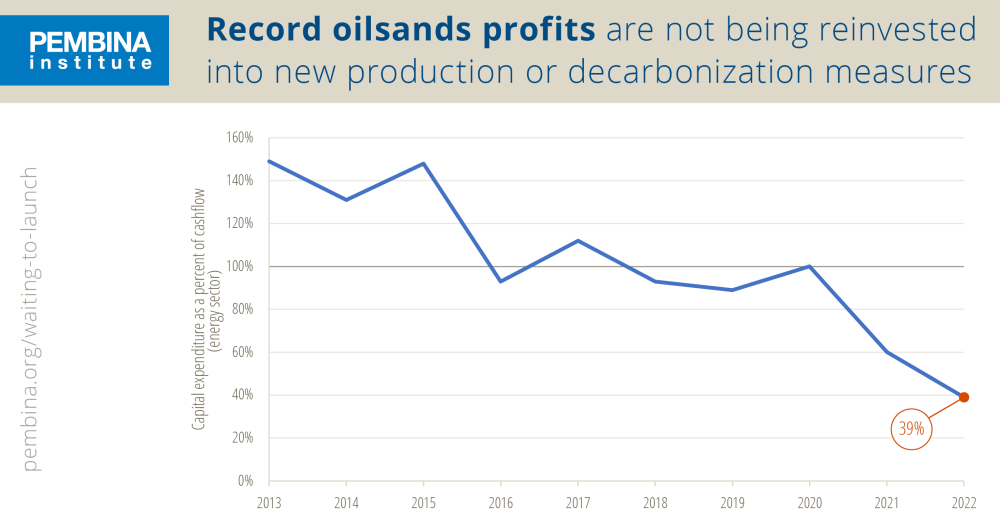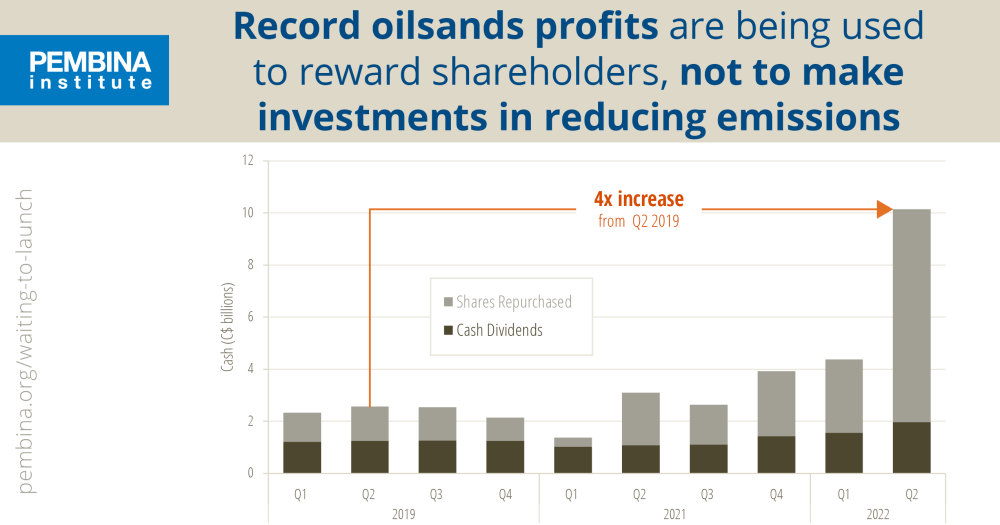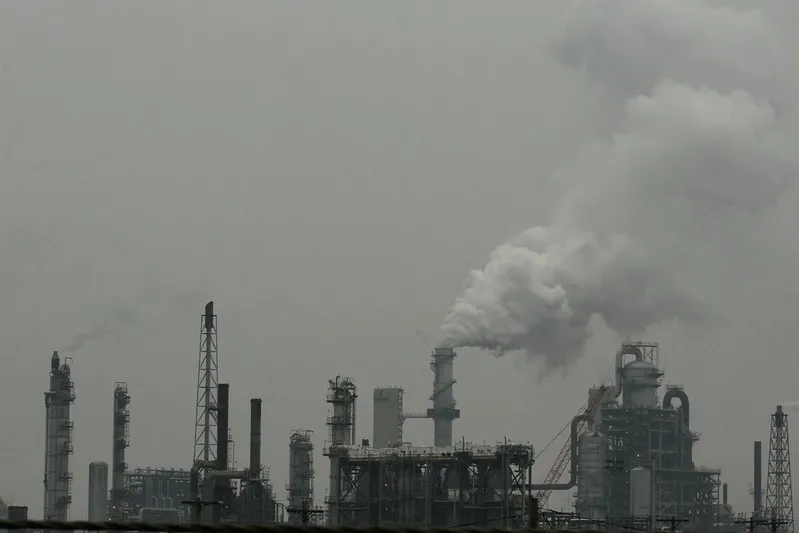CALGARY, AB — Oilsands companies must urgently provide more detail on their plans to decarbonize their operations, and make investments to turn those plans into reality, according to a new report from the Pembina Institute.
Waiting to Launch: the gap between Canadian oilsands companies’ climate pledges and actions examines the emissions reduction pledges of the Pathways Alliance – an industry grouping representing 95% of Canada’s oilsands production. In mid-2021, Pathways announced that its members were committed to reaching net-zero emissions by 2050, including a milestone emissions reduction target for 2030.
This report tracks progress on these pledges by examining decarbonization actions and investments made to date by Pathways member companies. It looks in detail at the decarbonization and sustainability announcements of each of the six Pathways companies and assesses their likely effectiveness in meeting the Pathways target.
Key findings include (also, see graphics below):
- In more than a year since Pathways was formed and released its plan, no significant decarbonization investment decisions have been made by any of its members.
- This is despite record profits in the sector that have left oilsands companies with more than double the level of cash they had in the most recent boom year, 2014,when crude oil prices were at $100 per barrel.
- This free cashflow has also not been allocated to new production investments, as would usually be the case during an oil price boom, potentially indicating that companies remain uncertain about the medium-to-long term future of their industry. Multiple scenarios, including from international oil majors, now show global oil demand declining by 2030.
- Historic profits have instead been channelled into short-term rewards to shareholders, in the form of dividends and share buybacks. These paymentshave increased exponentially in 2022.
- Aside from investment decisions, Pathways companies have released no further key details on their plan in the last year – such as the extent to which each company will contribute to their collective emissions reduction targets, where emissions reductions projects (such as carbon capture facilities) will be built, or the timelines for these projects.
Pembina Institute experts are available to talk about the report, its key findings, and the broader context of the urgent need to rapidly decarbonize oil and gas production in Canada, including the implementation of a clear cap on oil and gas sector emissions.
Quotes
Jan Gorski, director of the Pembina Institute’s oil and gas program, said:
“More than a year ago,Pembina welcomed the Pathways Alliance’s commitments to reduce emissions by 2030 and achieve net-zero emissions by 2050.But, since then, we haven’t seen the kind of detailed planning or announcements of projects that are necessary for this to happen.It is time for the oilsands companies to turn their words into actions.
Our research shows oilsands companies have all the funds and technology at their disposal to get started now. Those that make rapid and deep cuts to their emissions will be best-placed to compete in a near-future where governments and consumers will have increasingly high expectations about the emissions present in every supply chain. Those that do not, risk leaving behind significant financial liabilities – like tailings cleanup costs – to Canadian taxpayers.”
Chris Severson-Baker, executive director of the Pembina Institute said:
“Oil and gas companies, including in the oilsands, have repeatedly said they understand their responsibility as Canada’s biggest source of emissions, and that they intend to decarbonize. This report shows that everything is now aligned for them to get started: they have record levels of free cashflow at their disposal, along with a combination of federal incentives and regulations designed to shore up the investment environment for emission reduction projects. The bottom line is, oilsands companies mustavoid any further delay and make good on their own promises. In doing so, they will help to future-proof their own operations, while playing a meaningful role in Canada meeting its climate imperatives.”
Graphics



Contact
Alex Burton
Senior Communications Lead, Pembina Institute
825-994-2558
Background
Report: Waiting to Launch: the gap between Canadian oilsands companies’ climate pledges and actions
Report: Decarbonizing Canada’s oil and gas supply
Report: Getting on Track: A primer on challenges to reducing carbon emissions in Canada’s oilsands
Op-ed: Why the federal oil and gas emissions cap is a win for Albertans
Op-ed: Why Canada can meet its oil and gas emissions targets




